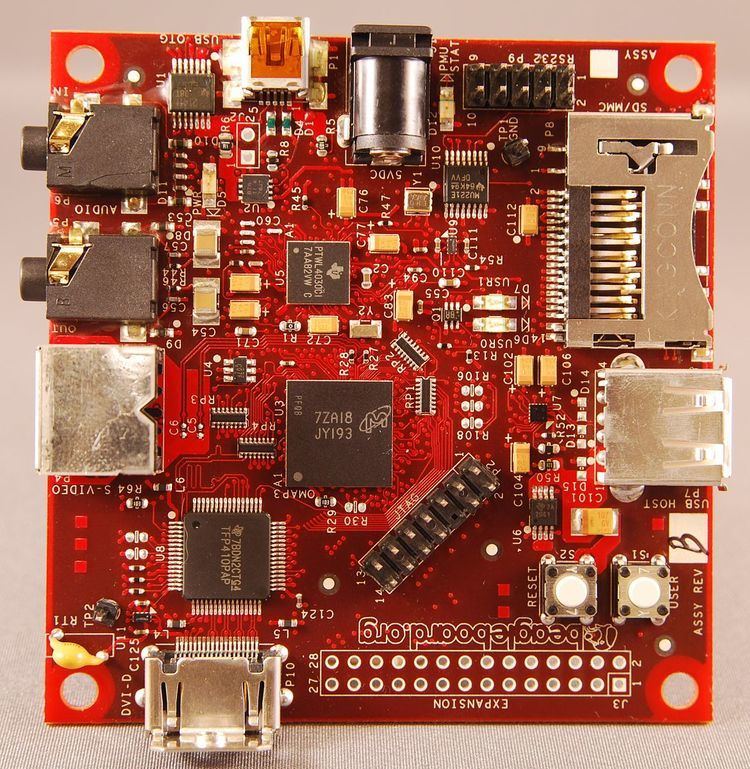Cost US$95 to $149 | ||
 | ||
Common manufacturers Circuitco LLC on behalf of BeagleBoard.org Introduced BeagleBoardJuly 28, 2008 (2008-07-28)BeagleBoard rev.CMay 13, 2009 (2009-05-13)BeagleBoard-xMSeptember 14, 2010 (2010-09-14)BeagleBoneOctober 31, 2011 (2011-10-31)BeagleBone BlackApril 23, 2013 (2013-04-23)BeagleBoard-X15November 1, 2015 (2015-11-01) | ||
The BeagleBoard is a low-power open-source hardware single-board computer produced by Texas Instruments in association with Digi-Key and Newark element14. The BeagleBoard was also designed with open source software development in mind, and as a way of demonstrating the Texas Instrument's OMAP3530 system-on-a-chip. The board was developed by a small team of engineers as an educational board that could be used in colleges around the world to teach open source hardware and software capabilities. It is also sold to the public under the Creative Commons share-alike license. The board was designed using Cadence OrCAD for schematics and Cadence Allegro for PCB manufacturing; no simulation software was used.
Contents
Features
The BeagleBoard measures approximately 75 by 75 mm and has all the functionality of a basic computer. The OMAP3530 includes an ARM Cortex-A8 CPU (which can run Linux, Minix, FreeBSD, OpenBSD, RISC OS, or Symbian; Android is also being ported), a TMS320C64x+ DSP for accelerated video and audio decoding, and an Imagination Technologies PowerVR SGX530 GPU to provide accelerated 2D and 3D rendering that supports OpenGL ES 2.0. Video out is provided through separate S-Video and HDMI connections. A single SD/MMC card slot supporting SDIO, a USB On-The-Go port, an RS-232 serial connection, a JTAG connection, and two stereo 3.5 mm jacks for audio in/out are provided.
Built-in storage and memory are provided through a PoP chip that includes 256 MB of NAND flash memory and 256 MB of RAM (128 MB on earlier models).
The board uses up to 2 W of power and can be powered from the USB connector, or a separate 5 V power supply. Because of the low power consumption, no additional cooling or heat sinks are required.
Rev. C4 specifications
Features
A modified version of the BeagleBoard called the BeagleBoard-xM started shipping on August 27, 2010. The BeagleBoard-xM measures in at 82.55 by 82.55 mm and has a faster CPU core (clocked at 1 GHz compared to the 720 MHz of the BeagleBoard), more RAM (512 MB compared to 256 MB), onboard Ethernet jack, and 4 port USB hub. The BeagleBoard-xM lacks the onboard NAND and therefore requires the OS and other data to be stored on a microSD card. The addition of the Camera port to the -xM provides a simple way of importing video via Leopard Board cameras.
Specifications
BeagleBone
Announced in the end of October 2011, the BeagleBone is a barebone development board with a Sitara ARM Cortex-A8 processor running at 720 MHz, 256 MB of RAM, two 46-pin expansion connectors, on-chip Ethernet, a microSD slot, and a USB host port and multipurpose device port which includes low-level serial control and JTAG hardware debug connections, so no JTAG emulator is required. The BeagleBone was initially priced at $89 USD.
A number of BeagleBone "Capes" have recently been released. These capes are expansion boards which can be stacked onto the BeagleBone Board (up to four at one time). BeagleBone capes include but are not limited to:
BeagleBone Black
Launched in April 23, 2013 at a price of $45. Among other differences, it increases RAM to 512 MB, the processor clock to 1 GHz, and it adds HDMI and 2 GB of eMMC flash memory. The BeagleBone Black also ships with Linux kernel 3.8, upgraded from the original BeagleBone's Linux kernel 3.2, allowing the BeagleBone Black to take advantage of Direct Rendering Manager (DRM).
BeagleBone Black Revision C (released in 2014) increased the size of the flash memory to 4 GB. This enables it to ship with Debian GNU/Linux installed. Previous revisions shipped with Ångstrom Linux.
BeagleBoard-X15
The BeagleBoard X15 was planned for November 2015. It is based on the TI Sitara AM5728 processor with two ARM Cortex-A15 cores running at 1.5 GHz, two ARM Cortex-M4 cores running at 212 MHz and two TI C66x DSP cores running at 700 MHz. The used processor provides USB 3.0 support and has a PowerVR Dual Core SGX544 GPU running at 532 MHz.
Specifications
The following operating systems are reported to have obtained support for the hardware used on the boards: Fedora, Android (code named rowboat), Ubuntu, openSUSE and Ångström. The board also supports other OSes such as FreeBSD, NetBSD, OpenBSD, QNX, MINIX 3, RISC OS, and Windows Embedded.
On June 29, 2015 the stamp-sized soldering module BeagleCore has been announced. It packages the Texas Instruments AM335x ARM Cortex-A8 processor as well as 4 GB 8-bit eMMC on-board flash storage and 512 MB DDR3 RAM into a module for use as a part of embedded systems.
